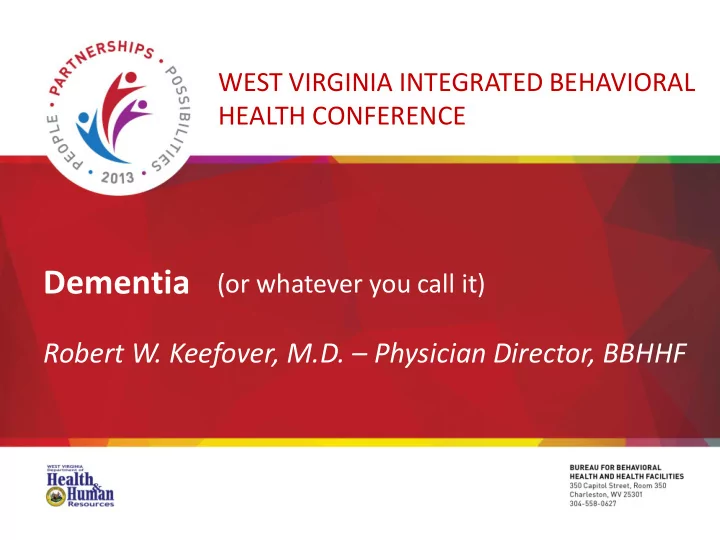

WEST VIRGINIA INTEGRATED BEHAVIORAL HEALTH CONFERENCE Dementia (or whatever you call it) Robert W. Keefover, M.D. – Physician Director, BBHHF
Merriam-Webster Dictionary: “DEMENTED” “DEMENT ED ” IA” 1.Mad, Insane 2.Suffering from or exhibiting cognitive dementia
Merriam-Webster Dictionary: “DEMENTIA” 1.Progressive condition marked by deteriorated cognitive function 1.Madness, Insanity
DSM-IV TR DSM-5: “DEMENTIA” DSM-IV
DSM-III R: “DEMENTIA” Acquired : 1. Short- and long-term memory impairment + 2. Impairment in abstract thinking, judgment, other higher cortical function or personality change 3. Cognitive disturbance interferes significantly with work, social activities or relationships with others 4. These cognitive changes do not occur exclusively in the setting of delirium
Neurocognitive Disorder Dementia Definition: Acquired : Cognitive impairment in domains such as: Memory (amnesia) Language (aphasia) Execution of purposeful movement (apraxia) Recognition/familiarity (agnosia) Visuospatial function (topographical disorientation) Self-control/management (executive function impairment) Mild NCD: 1 or more minor impairments, independent Major NCD: 1 or more significant impairments, independence lost
Why no dementia? • Move away from “dementia’s” negative connotation • Better distinguish disorders in which cognitive impairment is the primary feature • More accurately reflect the diagnostic process: 1. Explore symptoms 2. Identify diagnostic syndrome(s) 3. Find the cause
Frontal How do they happen? Impulsivity Pariatal • Injury to specific locations in the brain Poor Judgment Receptive Aphasia Inattention Topographical Disorientation, Abulia Somatagnosia Expressive Aphasia Occipital • Where injury occurs depends on underlying disease Cortical Blindness Temporal Anton’s Syndrome Receptive Aphasia Amnesia Dyscalculia
Common Dementia Diseases? All Others Parkinson’s Disease Fronto-temporal Lewy Body Disease • Maybe as many as 100 Dementia other conditions can • 25% eventually produce the syndrome • New in DSM 5 • Pick’s Disease in develop dementia of dementia • 2 nd most common ? DSM-IV-TR • Overlaps: AD & PD
What’s the problem? • Abnormally formed protein • Misshapen malfunctioning Amyloid Plaques Neurofibrillary Tangles produced in neurons cellular transport tubes • Excessive production or • Twisting and kinking occur impaired clearing leads to due to abnormal “Tau” accumulation protein • Cause or effect? • No longer deliver nutrients (Diabetes Type III ?) and remove waste from distant parts of neuron • Toxic to nearby brain cells
What’s the problem? • Larger vessel = Larger injury • Lacunar Infarcts Tiny vessels = small injury Left Parietal Stroke • Mostly outer portions affected • Affects deep brain areas • Immediate signs & symptoms • Slight or no immediate signs • Isolated cognitive impairment or symptoms • Gradual accumulation = gradual progression of multiple cognitive deficits
What’s the problem? Substantia Nigra Lewy Body • α -synuclein protein aggregates • Initially in Substantia nigra • ? Reason • Disrupts dopamine synthesis • Displaces normal cell structures NCDs appear as Gradual spread Basal nucleus & Dementia causes symptom cortext affected worsening
What’s the problem? Diffuse Lewy Bodies Lewy Body Cortical Lewy Bodies Alzheimer Plaques • Initially in limbic areas & cortex Lewy Bodies • Parkinson areas involved later
What’s the problem? Frontal & Temporal Lobe Atrophy Pick Bodies • Tangled tau protein aggregates • Shrinking of brain tissue in areas controlling memory, emotions, • The tau variant that predominates and executive functions determines the form of FTD diagnosed • Pick’s Disease (Tau 3R predominates) in DSM-IV-R • All are rare • Slightly more common in • No known genetic component women
HIV Huntington’s Disease • Autosomal dominant • Widespread viral-induced mutation of Huntingtin neurotoxins kill neurons gene (50% inheritance) • Fungal lesions, tumors, and • Degeneration of cells in other masses also cause focal basal ganglia striatum NCDs Prion Disease TBI • Non-viral infectious agents • cause “spongiform” injury Violent brain movement snaps neuron connections leading to • Creutzfeld-Jacob Disease in “retraction balls” DSM-IV-TR is human form of • Longer frontal lobe-directed Mad Cow Disease fibers most vulnerable
Substance-Medication Induced: Alcohol DSM-IV-TR DSM 5 a.k.a. Korsakoff’s Dementia (thiamine deficiency) Alcohol-Induced NCD No distinction Alcohol-Induced (Mild or Major) Persisting Amnesia a.k.a. Alcoholic Dementia Write in ICD-9 Subtypes? (chronic alcohol toxicity) • Amnestic-confabulatory Type Alcohol-Induced • Non-amnestic Type Persisting Dementia
Depend on: • Underlying Disease o Brain region(s) most affected o Diffuse v. focal injury o Rapidity of advancement • Advancement Stage • Even global disease may be localized initially
Symptom Patterns
Symptom Patterns
Any Mental Health/Medical Person Family Questionnaire Note if client/patient is: • Odd or poor historian Problem Caregiver Rating • Disheveled, inappropriately dressed, dirty 0 1 2 0 Medical Provider • Repeatedly late for or misses Conduct: Repeated Questioning None Sometimes Frequent N/A appointments (e.g., wrong time/day) • Standard Medical History 1. Screening Forgets appointments, • Has unexplained weight loss or vague None Sometimes Frequent N/A family events, etc. • Physical Exam symptoms Trouble writing checks, Frequent None Sometimes N/A • paying bills Poorly adaptive to stress • Functional Status (FAQ) 2. Assessing • Difficulties shopping Defers to family/caregiver to answer None Sometimes Frequent N/A independently • Mental Status (MMSE, GDS) Medical Provider questions directed to him/her Fails to follow Frequent None Sometimes N/A medication instructions Consider referral: • Labs (CBC, electrolytes, Glucose, BUN-Creatinine, Gets lost walking or None Sometimes Frequent N/A 3. Diagnosing TSH, Drug levels) • Neurology driving in familiar places • • Psychiatry Caregiver Interview (personal strain, patient behavior changes) • Neuropsychology Score of 4 or greater suggests need for further evaluation
Alzheimer’s Association: “Tools for Early Identification, Assessment, and Treatment of People with Alzheimer’s Disease and Dementia” alz.org/national/documents/brochure_toolsforidassesstreat.pdf
Recommend
More recommend